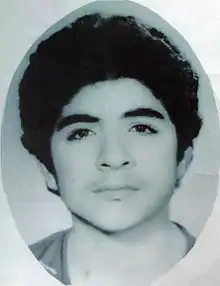Mohammad Hossein Fahmideh
Mohammad Hossein Fahmideh (Persian: محمد حسین فهمیده;[1] May 6, 1967 – October 30, 1980) was an Iranian war hero[2] and an icon of the Iran–Iraq war.
Mohammad Hossein Fahmideh | |
|---|---|
 Portrait of Fahmideh in the Martyrs' Museum, Tehran | |
| Native name | محمد حسین فهمیده |
| Born | May 6, 1967 Qom, Iran |
| Died | October 30, 1980 (aged 13) Khorramshahr, Iran |
| Buried | Behesht-e Zahra, Tehran |
| Allegiance | Iran |
| Service/ | Basij |
| Battles/wars | Iran–Iraq War |
| Awards | |
In September 1980, Iraq initiated the invasion of Iran via air and land, sending five armoured and mechanized divisions across the Shatt al-Arab (Arvand Rud) waterway to invade the oil-rich Khuzestan Province in southern Iran, quickly seizing several towns in the area, and, on November 10, attacked the city of Khorramshahr.[3]
According to his official biography,[4] Fahmideh was a 13-year-old boy from Qom who, at the outbreak of war in 1980,[5] left his home without his parents knowing to go to southern Iran and aid in the defense of Khorramshahr, the front line of the war.[6] In the besieged city of Khorramshahr, he fought side-by-side with older Iranian soldiers.[7] Fahmideh was among the Iranians who engaged in fierce house-to-house battles in which thousands of Iraqis and Iranians were killed.[3] At one point, Iraqi forces pushed the Iranian troops back as they were passing through a very narrow canal. Due to a lack of RPG rockets and the sensitive formation of the Iraqi tanks, Fahmideh, seeing that his older comrades were already dead or wounded,[8] wrapped himself in a grenade belt from a nearby body, pulled the pins out, and jumped underneath an advancing Iraqi tank, killing himself and disabling the tank.[9] This led the Iraqi tank column to believe that the Iranians had mined the area, ceasing their advance. Later, Voice of the Islamic Republic of Iran broadcast a breaking news story describing the incident.[10]
His story inspired many Iranians during the war to risk death to protect their nation and has been heralded by leaders in Iran from Ayatollah Khomeini to President Mohammad Khatami.[3] Ayatollah Khomeini declared Fahmideh an Iranian national hero,[11] and made references to him in several of his speeches:[3][8]
Our leader is that 13-years-old child who threw himself with his little heart against the enemy. He is worth more than a hundred pens and a hundred tongues.
Fahmideh is buried in Behesht-e Zahra cemetery in Tehran in section 24, row 44, no. 11.[10] A monument to him was erected on the outskirts of Tehran and has become a place of pilgrimage for young Iranians.[12][13] In the years following Hossein's death, murals have been erected throughout Iran, book bags displaying Hossein were sold to children, and, in 1986, a postage stamp was issued in his memory.[14] Streets, hospitals, schools, and a sports stadium have been named in his honor.[3] The day of his death, October 30, marks the "Student Basij Day" in the official calendar of Iran.[15]
Fahmideh was posthumously awarded the 1st grade Fath Medal on September 27, 1989 after the Iran–Iraq War, becoming its first recipient.[16]
See also
References
- Persian pronunciation: [mohæmmæd hoˌsejne fæhmiːˈde]
- "Archived copy". Archived from the original on 2004-12-16. Retrieved 2004-12-16.CS1 maint: archived copy as title (link)
- Davis, Joyce (2004). Martyrs: Innocence, Vengeance, and Despair in the Middle East. Palgrave Macmillan. pp. 49–50. ISBN 9781403966810.
- "Put a stop to it". 8 October 2003.
- "Archived copy" (PDF). Archived from the original (PDF) on 2009-01-06. Retrieved 2009-03-24.CS1 maint: archived copy as title (link)
- "Archived copy". Archived from the original on 2008-09-05. Retrieved 2009-03-24.CS1 maint: archived copy as title (link)
- "Archived copy". Archived from the original on 2007-10-31. Retrieved 2007-10-31.CS1 maint: archived copy as title (link)
- Mitchell, Jolyon (2012). Promoting peace, inciting violence : the role of religion and media. Abingdon, Oxon: Routledge. p. 49. ISBN 9780415557467.
- "Fars News Agency :: Commander Stresses IRGC Readiness to Combat Enemy Troops in PG". web.archive.org. October 31, 2007. Archived from the original on 2007-10-31.
- "شهادت دانش آموز بسیجی محمد حسین فهمیده".
- "Archived copy". Archived from the original on 2013-11-11. Retrieved 2009-03-24.CS1 maint: archived copy as title (link)
- "The Times & The Sunday Times". www.thetimes.co.uk.
- "Shahid Fahmideh". Archived from the original on 2007-11-02. Retrieved 2007-03-26.
- "Info" (PDF). web.mit.edu. Retrieved 2020-06-09.
| Wikimedia Commons has media related to Mohammad Hossein Fahmideh. |